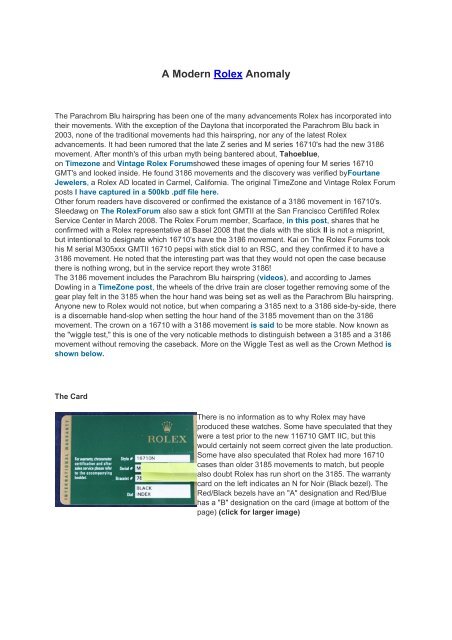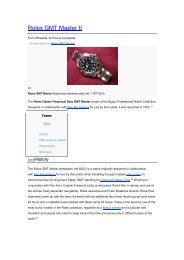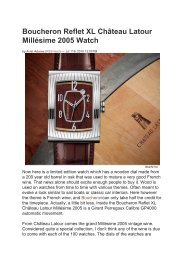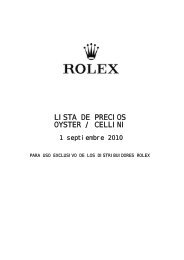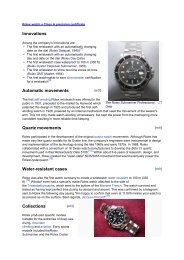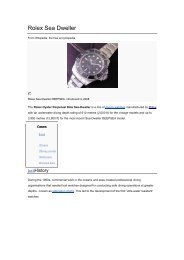The Parachrom Blu hairspring has been... - GINAULT
The Parachrom Blu hairspring has been... - GINAULT
The Parachrom Blu hairspring has been... - GINAULT
You also want an ePaper? Increase the reach of your titles
YUMPU automatically turns print PDFs into web optimized ePapers that Google loves.
A Modern Rolex Anomaly<br />
<strong>The</strong> <strong>Parachrom</strong> <strong>Blu</strong> <strong>hairspring</strong> <strong>has</strong> <strong>been</strong> one of the many advancements Rolex <strong>has</strong> incorporated into<br />
their movements. With the exception of the Daytona that incorporated the <strong>Parachrom</strong> <strong>Blu</strong> back in<br />
2003, none of the traditional movements had this <strong>hairspring</strong>, nor any of the latest Rolex<br />
advancements. It had <strong>been</strong> rumored that the late Z series and M series 16710's had the new 3186<br />
movement. After month's of this urban myth being bantered about, Tahoeblue,<br />
on Timezone and Vintage Rolex Forumshowed these images of opening four M series 16710<br />
GMT's and looked inside. He found 3186 movements and the discovery was verified byFourtane<br />
Jewelers, a Rolex AD located in Carmel, California. <strong>The</strong> original TimeZone and Vintage Rolex Forum<br />
posts I have captured in a 500kb .pdf file here.<br />
Other forum readers have discovered or confirmed the existance of a 3186 movement in 16710's.<br />
Sleedawg on <strong>The</strong> RolexForum also saw a stick font GMTII at the San Francisco Certififed Rolex<br />
Service Center in March 2008. <strong>The</strong> Rolex Forum member, Scarface, in this post, shares that he<br />
confirmed with a Rolex representative at Basel 2008 that the dials with the stick II is not a misprint,<br />
but intentional to designate which 16710's have the 3186 movement. Kai on <strong>The</strong> Rolex Forums took<br />
his M serial M305xxx GMTII 16710 pepsi with stick dial to an RSC, and they confirmed it to have a<br />
3186 movement. He noted that the interesting part was that they would not open the case because<br />
there is nothing wrong, but in the service report they wrote 3186!<br />
<strong>The</strong> 3186 movement includes the <strong>Parachrom</strong> <strong>Blu</strong> <strong>hairspring</strong> (videos), and according to James<br />
Dowling in a TimeZone post, the wheels of the drive train are closer together removing some of the<br />
gear play felt in the 3185 when the hour hand was being set as well as the <strong>Parachrom</strong> <strong>Blu</strong> <strong>hairspring</strong>.<br />
Anyone new to Rolex would not notice, but when comparing a 3185 next to a 3186 side-by-side, there<br />
is a discernable hand-slop when setting the hour hand of the 3185 movement than on the 3186<br />
movement. <strong>The</strong> crown on a 16710 with a 3186 movement is said to be more stable. Now known as<br />
the "wiggle test," this is one of the very noticable methods to distinguish between a 3185 and a 3186<br />
movement without removing the caseback. More on the Wiggle Test as well as the Crown Method is<br />
shown below.<br />
<strong>The</strong> Card<br />
<strong>The</strong>re is no information as to why Rolex may have<br />
produced these watches. Some have speculated that they<br />
were a test prior to the new 116710 GMT IIC, but this<br />
would certainly not seem correct given the late production.<br />
Some have also speculated that Rolex had more 16710<br />
cases than older 3185 movements to match, but people<br />
also doubt Rolex <strong>has</strong> run short on the 3185. <strong>The</strong> warranty<br />
card on the left indicates an N for Noir (Black bezel). <strong>The</strong><br />
Red/Black bezels have an "A" designation and Red/<strong>Blu</strong>e<br />
<strong>has</strong> a "B" designation on the card (image at bottom of the<br />
page) (click for larger image)
<strong>The</strong> Case<br />
the Stick Font II are listed below.<br />
(click for larger image)<br />
This is certainly a rare anomaly of Rolex production. All<br />
four are M serials two came with black bezel and two with<br />
Pepsi bezel. <strong>The</strong>re is no notation on the paperwork or<br />
otherwise to indicate they have the 3186—-the only way to<br />
determine the type of movement is to open the watch to<br />
confirm. Another possible example in Finland (with Z serial)<br />
<strong>has</strong> <strong>been</strong> mentioned in a previous post on the watch<br />
forums. You will also notice that the pictured watch <strong>has</strong> an<br />
unusual dial—-the "II" of "GMT-Master II" is in "non-roman,"<br />
or "stick" font. <strong>The</strong> stick II on GMT's have <strong>been</strong> bantered<br />
about regarding the GMT's collectability and possible dial<br />
printing error. <strong>The</strong>re are many GMTII's with the same dial,<br />
presumably without the 3186. Interestingly all four of the<br />
noted 3186 GMT II’s have this dial variant. More images of<br />
Caseback Removed<br />
<strong>The</strong>re was thought that one reason Rolex increased the<br />
case thickness for the new 116710 was to accommodate<br />
an increased height of the 3186 calibre. But as as the<br />
photos show, the 3186 fits nicely in the older case.<br />
(click for larger image)<br />
This picture from<br />
another source<br />
shows the<br />
<strong>Parachrom</strong>e<br />
<strong>hairspring</strong>, but<br />
look closely, the<br />
baseplate<br />
appears to show<br />
3185.<br />
(click for larger<br />
image)
It's definately a 3186<br />
<strong>The</strong> 3186 on the movement definately insures the<br />
movement number.<br />
(click for larger image)<br />
... And another 3186<br />
Charles<br />
Newgass<br />
on Timezone<br />
purc<strong>has</strong>ed a<br />
late<br />
series M3XXXXXX Coke bezeled 16710. He indicated that when unscrewing the crown and changed<br />
the 24 hour hand, none of the hands wiggled, a tell-tale sign between a 3185 and 3186 movement as<br />
the wheel train is closer together on a 3186.<br />
Charles had the back removed and found a 3186 movment.<br />
(click for larger image; photo used with permission)<br />
Distance to the Crown<br />
<strong>The</strong> thickness between the crown and the movement is<br />
definately less than the upgraded 116710 case. This is<br />
definately a traditional 16710 case.<br />
(click for larger image)<br />
Tahoeblue definately blew this urban myth. Our thanks to<br />
his fortitude on correcting what many had thought was<br />
sheer nonsense. With this discovery, there is a good<br />
chance that M-series Explorer II's might have the same<br />
3186 movement.<br />
-Pictures and text re-posted with permission from Tahoeblue.


